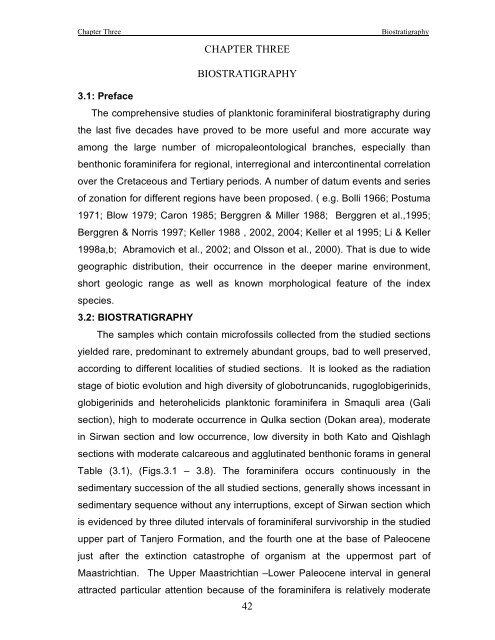biostratigraphy and paleoecology of cretaceous/tertiary boundary in ...
biostratigraphy and paleoecology of cretaceous/tertiary boundary in ...
biostratigraphy and paleoecology of cretaceous/tertiary boundary in ...
You also want an ePaper? Increase the reach of your titles
YUMPU automatically turns print PDFs into web optimized ePapers that Google loves.
Chapter Three Biostratigraphy<br />
CHAPTER THREE<br />
BIOSTRATIGRAPHY<br />
3.1: Preface<br />
The comprehensive studies <strong>of</strong> planktonic foram<strong>in</strong>iferal <strong>biostratigraphy</strong> dur<strong>in</strong>g<br />
the last five decades have proved to be more useful <strong>and</strong> more accurate way<br />
among the large number <strong>of</strong> micropaleontological branches, especially than<br />
benthonic foram<strong>in</strong>ifera for regional, <strong>in</strong>terregional <strong>and</strong> <strong>in</strong>tercont<strong>in</strong>ental correlation<br />
over the Cretaceous <strong>and</strong> Tertiary periods. A number <strong>of</strong> datum events <strong>and</strong> series<br />
<strong>of</strong> zonation for different regions have been proposed. ( e.g. Bolli 1966; Postuma<br />
1971; Blow 1979; Caron 1985; Berggren & Miller 1988; Berggren et al.,1995;<br />
Berggren & Norris 1997; Keller 1988 , 2002, 2004; Keller et al 1995; Li & Keller<br />
1998a,b; Abramovich et al., 2002; <strong>and</strong> Olsson et al., 2000). That is due to wide<br />
geographic distribution, their occurrence <strong>in</strong> the deeper mar<strong>in</strong>e environment,<br />
short geologic range as well as known morphological feature <strong>of</strong> the <strong>in</strong>dex<br />
species.<br />
3.2: BIOSTRATIGRAPHY<br />
The samples which conta<strong>in</strong> micr<strong>of</strong>ossils collected from the studied sections<br />
yielded rare, predom<strong>in</strong>ant to extremely abundant groups, bad to well preserved,<br />
accord<strong>in</strong>g to different localities <strong>of</strong> studied sections. It is looked as the radiation<br />
stage <strong>of</strong> biotic evolution <strong>and</strong> high diversity <strong>of</strong> globotruncanids, rugoglobiger<strong>in</strong>ids,<br />
globiger<strong>in</strong>ids <strong>and</strong> heterohelicids planktonic foram<strong>in</strong>ifera <strong>in</strong> Smaquli area (Gali<br />
section), high to moderate occurrence <strong>in</strong> Qulka section (Dokan area), moderate<br />
<strong>in</strong> Sirwan section <strong>and</strong> low occurrence, low diversity <strong>in</strong> both Kato <strong>and</strong> Qishlagh<br />
sections with moderate calcareous <strong>and</strong> agglut<strong>in</strong>ated benthonic forams <strong>in</strong> general<br />
Table (3.1), (Figs.3.1 – 3.8). The foram<strong>in</strong>ifera occurs cont<strong>in</strong>uously <strong>in</strong> the<br />
sedimentary succession <strong>of</strong> the all studied sections, generally shows <strong>in</strong>cessant <strong>in</strong><br />
sedimentary sequence without any <strong>in</strong>terruptions, except <strong>of</strong> Sirwan section which<br />
is evidenced by three diluted <strong>in</strong>tervals <strong>of</strong> foram<strong>in</strong>iferal survivorship <strong>in</strong> the studied<br />
upper part <strong>of</strong> Tanjero Formation, <strong>and</strong> the fourth one at the base <strong>of</strong> Paleocene<br />
just after the ext<strong>in</strong>ction catastrophe <strong>of</strong> organism at the uppermost part <strong>of</strong><br />
Maastrichtian. The Upper Maastrichtian –Lower Paleocene <strong>in</strong>terval <strong>in</strong> general<br />
attracted particular attention because <strong>of</strong> the foram<strong>in</strong>ifera is relatively moderate<br />
42

















